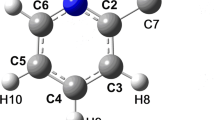Abstract
In order to furnish a reliable interpretation of the1H-NMR spectrum of [2.2]metacyclophane (1) based on the ring current theory two basic conditions must be fullfilled:
-
1.
Bond lengths angle deformations due to the puckered topology of the molecule must be taken into account. The geometry parameters can be deduced fromX-ray data.
-
2.
The (fictive) reference chemical shift of the system (i.e. unperturbed by the “second” benzene ring) must be established since the Δ δ's ofBovey's ring current formula have to be related to a reference.
The shifts calculated on the basis of these assumptions are in agreement with the actual spectrum.
Moreover, it can be shown that for basic reasons a quantitative approach to the chemical shift of the methylene protons in the bridgevia ring current theory is impossible.
Similar content being viewed by others
Literatur
D. J. Wilson, V. Boekelheide undR. W. Griffin, J. Amer. Chem. Soc.82, 6302 (1960).
S. Akabori, T. Sato undK. Hata, J. Org. Chem.33, 3277 (1968).
H. S. Gutowsky undC. Juan, J. Chem. Phys.37, 120 (1962).
N. L. Allinger, B. J. Gorden, S. E. Hu undR. A. Ford, J. Org. Chem.32, 2272 (1967).
K. Burri undW. Jenny, Helv. Chim. Acta50, 1978 (1967).
J. A. Pople, J. Chem. Phys.24, 1111 (1956); J. Mol. Phys.1, 175 (1958);H. J. Bernstein, W. G. Schneider undJ. A. Pople, Proc. Roy. Soc.A 236, 515 (1965).
C. J. Brown, J. Chem. Soc.1953, 3278.
M. G. Newton, T. J. Walter undN. L. Allinger, J. Amer. Chem. Soc.95, 5652 (1973).
J. S. Waugh undR. W. Fessenden, J. Amer. Chem. Soc.79, 846 (1957).
R. A. Hoffmann, S. Forsen undB. Gestblom, in: NMR-Grundlagen und Fortschritte (P. Diehl, E. Fluck undR. Kosfeld, Hrsg.), Bd. 5 Berlin-Heidelberg-New York: Springer. 1971.
J. W. Emsley, J. Feeney undL. H. Sutcliffe, High Resolution NMR-Spectroscopy, Bd. 1 und 2. Pergamon Press. 1966.
E. Langer undH. Lehner, Tetrahedron29, 375 (1973).
R. Eberhardt, H. Lehner undK. Schlögl, Mh. Chem.104, 1409 (1973).
W. Baker, J. F. W. McOmie undJ. M. Norman, J. Chem. Soc.1951, 1114.
C. E. Johnson undF. A. Bovey, J. Chem. Phys.29, 1012 (1958).
Author information
Authors and Affiliations
Additional information
Mit 1 Abbildung
Rights and permissions
About this article
Cite this article
Glotzmann, C., Langer, E. & Lehner, H. Zur diamagnetischen Anisotropie im [2.2]Metacyclophan. Monatshefte für Chemie 105, 354–361 (1974). https://doi.org/10.1007/BF00907384
Received:
Issue Date:
DOI: https://doi.org/10.1007/BF00907384




